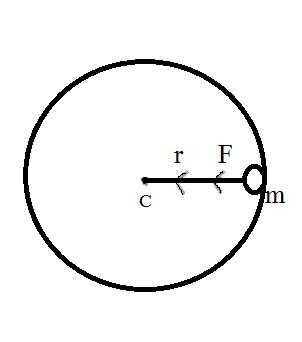
A stone of mass \[m\] tied to a string of length \[l\] is rotating along a circular path with constant speed \[v\]. What is the torque on the stone?
Answer
504k+ views
Hint: Uniform circular motion describes the movement of an object along a circular path with constant speed. Angular and tangential acceleration will be zero. Angular velocity and linear speed of the particle are always constant. The kinetic energy of the particle also remains constant. The net linear acceleration of the particle is always radially inwards. The magnitude of centripetal force remains constant. The magnitude of centripetal acceleration within a uniform circular motion is also constant. The examples of uniform circular motion are motion of the Earth around the Sun, second, minute and hour hands of the watch, motion of cyclists on a circular track, etc.
Formula used: \[T = r \times F\]
Where, \[T\]-Tension,\[r\]-radial direction, and \[F\]- the force acting on the mass.
Complete step-by-step solution:

\[T = r \times F\]
Where, \[T\]-Tension,\[r\]-radial direction, and \[F\]- the force acting on the mass.
The radial direction would be from stone to center (\[c\]) of the circular path. \[F\] is the force acting on mass(\[m\]). We all know that, if the body is moving within a circular motion, definitely there’ll be a centrifugal force working along the center of the path.
Clearly, \[r\] and \[F\] working on the same axis or parallel to each other.
Finally, we can say that the net torques are zero.
Note: Torque is termed as the measure of the force that can cause an object to rotate about an axis. Force is what causes an object to accelerate within linear kinematics. Similarly, torque is what causes an angular acceleration. Hence, torque can be termed as the rotational equivalent of linear force. In physics, torque is solely the tendency of a force to turn or twist. Different terminologies like moment or moment of force are interchangeably used to describe torque.
Formula used: \[T = r \times F\]
Where, \[T\]-Tension,\[r\]-radial direction, and \[F\]- the force acting on the mass.
Complete step-by-step solution:

\[T = r \times F\]
Where, \[T\]-Tension,\[r\]-radial direction, and \[F\]- the force acting on the mass.
The radial direction would be from stone to center (\[c\]) of the circular path. \[F\] is the force acting on mass(\[m\]). We all know that, if the body is moving within a circular motion, definitely there’ll be a centrifugal force working along the center of the path.
Clearly, \[r\] and \[F\] working on the same axis or parallel to each other.
Finally, we can say that the net torques are zero.
Note: Torque is termed as the measure of the force that can cause an object to rotate about an axis. Force is what causes an object to accelerate within linear kinematics. Similarly, torque is what causes an angular acceleration. Hence, torque can be termed as the rotational equivalent of linear force. In physics, torque is solely the tendency of a force to turn or twist. Different terminologies like moment or moment of force are interchangeably used to describe torque.
Recently Updated Pages
Master Class 11 Chemistry: Engaging Questions & Answers for Success

Why are manures considered better than fertilizers class 11 biology CBSE

Find the coordinates of the midpoint of the line segment class 11 maths CBSE

Distinguish between static friction limiting friction class 11 physics CBSE

The Chairman of the constituent Assembly was A Jawaharlal class 11 social science CBSE

The first National Commission on Labour NCL submitted class 11 social science CBSE

Trending doubts
What is meant by exothermic and endothermic reactions class 11 chemistry CBSE

10 examples of friction in our daily life

One Metric ton is equal to kg A 10000 B 1000 C 100 class 11 physics CBSE

Difference Between Prokaryotic Cells and Eukaryotic Cells

What are Quantum numbers Explain the quantum number class 11 chemistry CBSE

1 Quintal is equal to a 110 kg b 10 kg c 100kg d 1000 class 11 physics CBSE




